If you’re looking for patellar tendonitis stretches you need to know three things:
1) Which muscles you need to stretch.
2) When not to stretch.
3) How much improvement you can expect from stretching.
Let’s start with number one.
Stretches for the patellar tendon
Research has repeatedly shown a connection between muscle tightness in the legs and an increased risk of patellar tendonitis[1]. The three muscle groups with the strongest evidence are the calves[2], the hamstrings[3], and the quadriceps muscles[4].
Feedback from people with patellar tendonitis also confirms that stretching exercises can help with recovery from and prevention of patellar tendonitis and we’re going to look at some great evidence on that later.
A word of warning: don’t try these stretches unless you’ve been cleared for this by your doctor and be sure to watch the part of this video where we talk about when not to stretch.
Now let’s start with the least popular of the three patellar tendonitis stretches: the calf stretch.
Calf Stretch
I recommend foam-rolling the muscles before stretching. This helps if you’re particularly tight. My favorite calf stretch is just standing on a slanted board. If this is too difficult for you, you can start by leaving your heels on the ground.
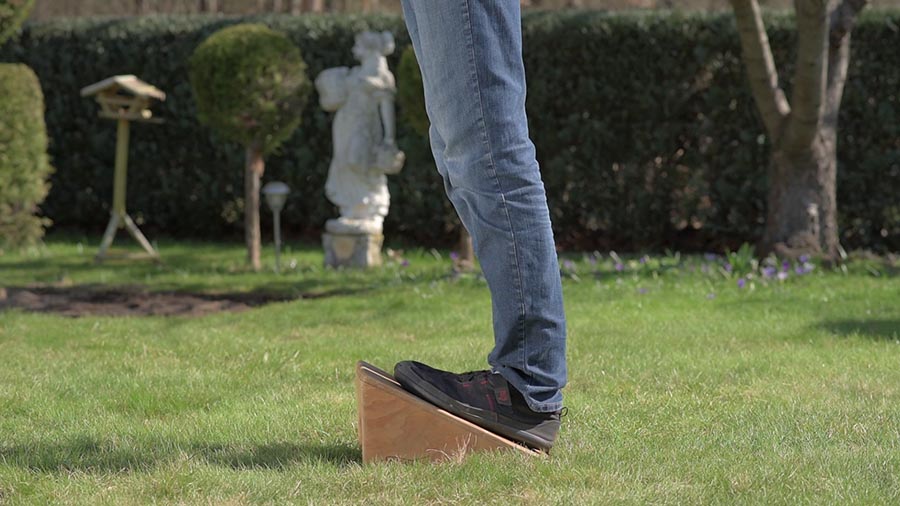
Keep your feet parallel and pointed forward and try to keep your knees straight. You also want to feel the stretch in your calves and not in your Achilles tendons. Relax deeper into the stretch for at least two or three minutes.
Now there are many different versions of the calf stretch, but I always come back to the one on the slanted board because it’s the most convenient version and so easy to do. You just have to stand there. You could even watch TV or read a book while you’re at it.
Hamstring Stretch
There are probably more variations of the hamstring stretch than days in a month. You can stretch both legs simultaneously or one leg at a time, you can stretch using your body weight only, or by pulling yourself into the stretch, you can use a strap to pull the leg closer, you can stretch the hamstrings with the knees slightly bent or completely straight, you can do isolated stretching or integrate the stretch into a mobility exercise, and on and on the list goes.
I’m sure there are stretching fanatics out there with strong opinions about what’s best and why everything else sucks, but in my experience it’s better to try different exercises to find what works best for you than to blindly stick with someone’s recommendation.
So I’m going to give you my two favorite hamstring stretches, but I’d still encourage you to try others as well. Also, just because I say favorite doesn’t mean I actually like stretching hamstrings.
1) The Belt Stretch
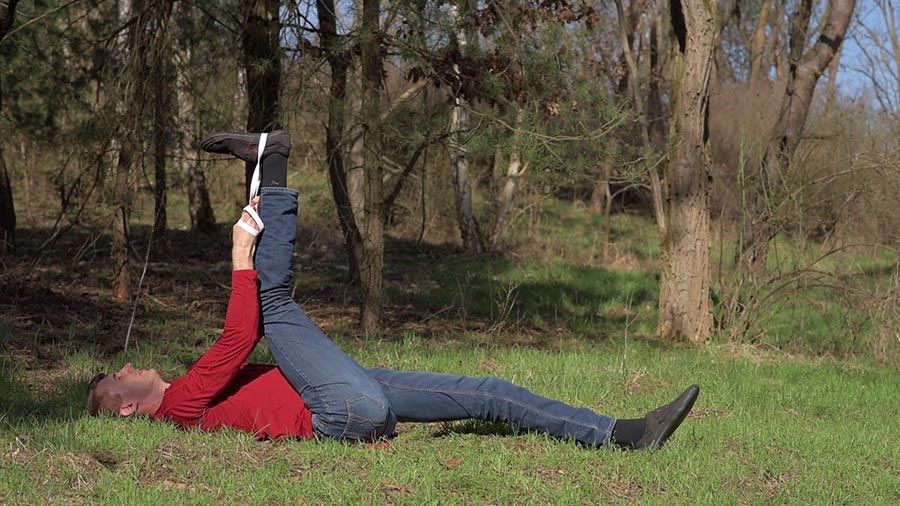
In this simple stretch you lie on your back, pull one leg up and then loop a belt or strap around the heel. Now you can stretch the hamstring of that leg by pulling the leg closer. You can do this as a passive stretch by just letting the hamstring yield to the force or you can do it as contract-relax stretch.
To do the contract-relax version you actively resist the pull of the strap by pushing into it with your heel. This puts tension into your hamstring. Push hard for a few seconds and then relax all muscles with an audible sigh of relief. The important part is to not keep pulling on the strap as you relax the hamstrings, but let all muscles rest for maybe a second. Then you can gently pull the leg closer.
With each round you’ll get deeper into the stretch. It’s not fun, but it works, just like this next one.
2) The Boot-Strapper
The boot-strapper is a mobility exercise and stretch for the hamstrings. I learned this from Steve Maxwell, who has about a hundred other fantastic mobility drills like this in arsenal, so go check him out if you’re into mobility work.
In the boot-strapper you’re working your quadriceps muscles against the resistance of your hamstring muscles, which can also give you a gentle cardiovascular workout.
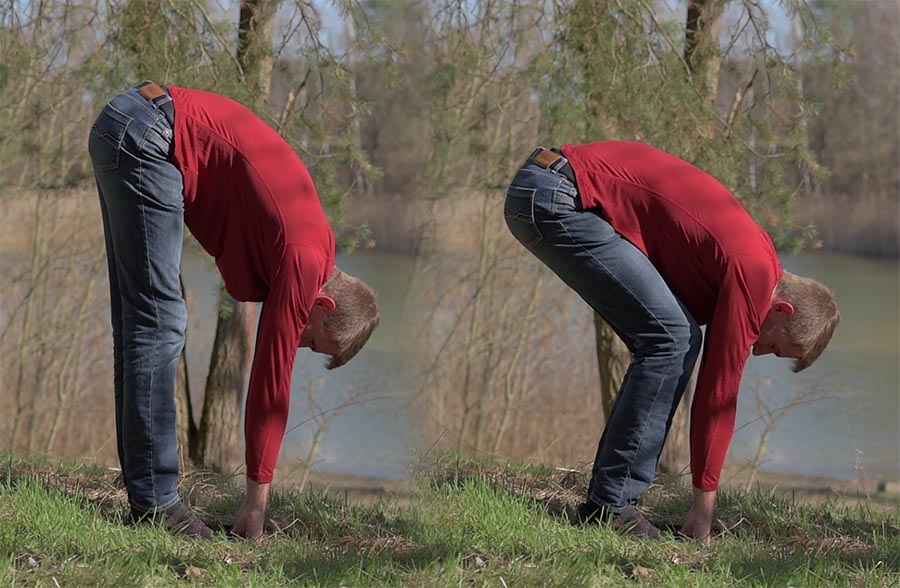
You stand with your feet about hip-width apart and pointed forward. Now you bend your knees and lean forward to touch the ground with your hands.
The easiest difficulty of this exercise is doing it with just your fingertips touching the ground. Depending on how flexible you are you can then progress to touching your knuckles and later-on your palms to the ground.

If you’re super flexible you can place your palms on the side of your feet.
Now you exhale as you straighten your knees, hold for a brief moment, and inhale while bending them. To do this as a workout squat all the way down, but if you’re just doing it for hamstring flexibility you can work in the top part of the movement.
Exhale as you straighten the knees and inhale as you flex the knees.
You can do up to 100 repetitions, but 30 to 50 are sufficient in the beginning. If your knees are easily irritated, this exercise may still be too tough for you. So be careful if you’re trying it for the first time.
Quadriceps Stretching Exercises for Patellar Tendonitis
The two stretching exercises for the quadriceps that I’ve found work best are the couch stretch and the wall quad stretch. I learned both of these from Dr. Kelly Starrett.
1) Couch Stretch
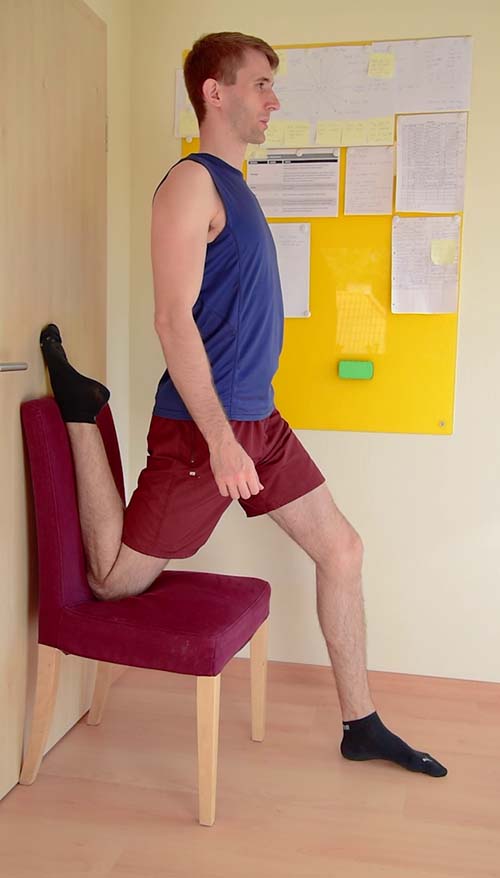
The couch stretch is the gentler quad stretch of the two. You do it by standing in front of a couch and then placing your knee all the way into the back corner. Don’t leave any space between your knee and the backrest. Now push up and keep your abs and glutes braced to maintain a neutral spine.
You don’t want to go into lumbar hyperextension, because that takes makes the stretch a lot less effective and also places your back at risk.
If you’re unsure about the correct alignment you can do the exercise with a stick behind your back. Keep the stick in contact with your tailbone, your upper back, and your head. There should be just enough space in the lower back region so that you can slide a couple of fingers through, but not more.
Now you can experiment with how you need to work your core muscles to maintain those points of contact and once you’ve figured it out you can sink deeper into the stretch.
And by the way, this lumbar hyperextension is something you’ll see in a lot of hip flexor and quad stretches. The rectus femoris from your quads attaches to the front of the hip and the hip flexors attach to the front of the hip as well as the lumbar spine. Stretches for both of these muscle groups exert a force that tries to tilt the hip forward and pulls the lumbar spine forward and down.
The second quadriceps stretch is the wall quad stretch.
2) Wall Quad Stretch
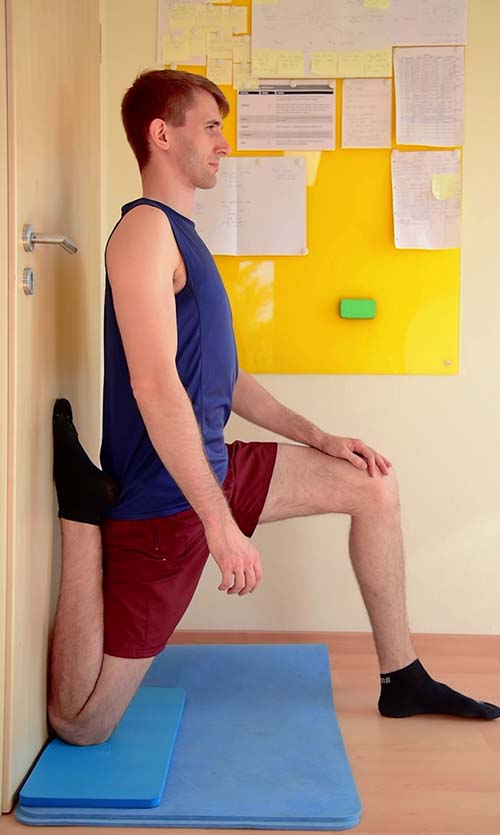
The wall quad stretch is the big brother of the couch stretch: more intense, but also a bit more difficult to get into.
Set up in front of the wall and have a thick pillow or folded blanket ready as a cushion. Now you kneel down and place the rear leg all the way up to the wall, with your shin touching the wall. Next you push up, again keeping your glutes and core braced to maintain a neutral spine.
Eventually the quads relax and you can sink deeper into stretch. Keep your breathing relaxed and stay in the stretch for at least two minutes per side.
But as great as all these stretches are, there are times when you should NOT stretch.
When NOT to Stretch
You want to be careful with these stretches if you have problems with the tendons that attach to them. So if you have Achilles tendonitis, use the calf stretch only if you feel it in your calves and not in the tendon. The same thing applies to the hamstring stretch if you have hamstring tendinopathy and to the quadriceps stretches if you have quad or patellar tendonitis.
For patellar tendonitis in particular you shouldn’t stretch if it causes increased pain in the tendon. In that case you can use self-massage to relieve tension from the quads. The good news is that after a few weeks of tendon strengthening work your tendons will likely be able to tolerate the stretching, but until then it’s better to avoid stretching if it causes a flare-up of pain.
Now the big question that remains is:
How Much Does Stretching Really Help?
How much does stretching really help? Print: How do these knee tendonitis stretches really help?
I have a few thousand people with patellar tendonitis in my free email course about the injury so I just asked them a couple of questions about their experience with stretching and a little over 300 took the time to respond. Thank you for that. Here are the results.
My first question was “Did stretching help your knee feel better?”

75% of people responded with yes, stretching helped my knees feel better.
One the other hand, stretching didn’t have an impact for about 14% and 5% felt worse after stretching.
The additional remarks people left in the survey suggest that of those 14% for whom it didn’t work, a certain percentage was already very flexible. So if you have patellar tendonitis but are already are flexible you may not benefit from stretching.
Next I asked about whether stretching was more useful for rehab or for prevention, but the results were pretty much a toss-up with rehab coming in a bit higher.
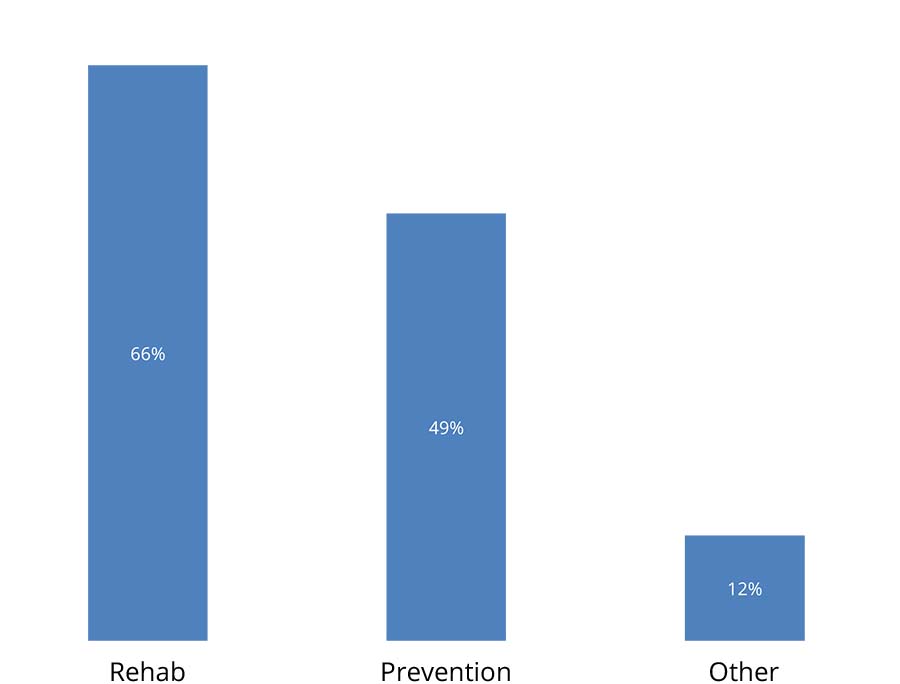
In this question people could check more than one answer and while the results leave room for interpretation my biggest takeaway is that even after you’re back to sports, stretching will still play a role in keeping you pain-free, at least for most people.
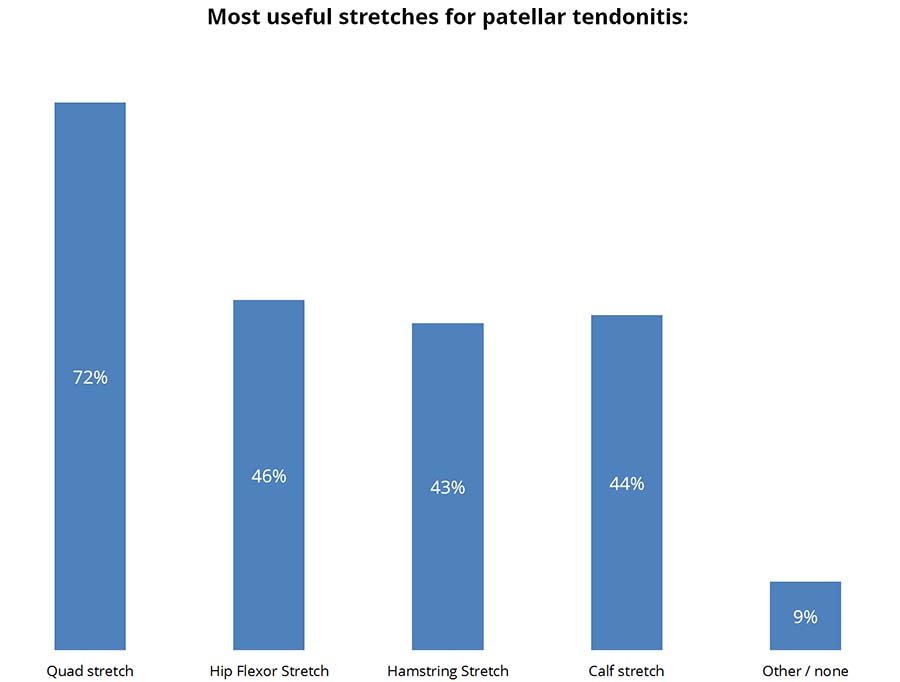
The final question was about which stretches were most beneficial. The quad stretch came in first with 72%. The other three answers, hip flexor stretch, hamstring stretch, and calf stretch, all came in tied for 2nd place since there’s no statistically significant difference between them.
About 8% of those I included in the last bar didn’t find any stretches useful and less than 1% added their own answers mentioning stretches for the glutes, lower back, or feet, but since the number is so small these seem to be just fringe cases.
So the answer to our initial question “Do knee tendonitis stretches really help?” is yes, stretching does help for most people, especially during rehab, but also later on when they’re back in sports. The most useful stretch is the quad stretch, followed by the other 3 stretches, but ultimately you’ll still have to try all of them to find which ones your body needs.
I think that sums it all up nicely.
Patellar Tendonitis Stretches PDF Download
You can download this article as PDF by clicking here.
Beyond just stretching…
Now if you have patellar tendonitis but have not yet signed up to my free email course about what works and what doesn’t, just take a moment and get started today. Because getting better is not just about knowing all the exercises, but also about staying motivated to stick to the plan.
Martin,
I watched the videos you emailed me a few months ago and started doing the stretches/exercises. I do them fairly regularly. I wanted to tell you that they have really helped! My knee rarely experiences any tinge of pain at all and I am much improved. Thank you for your great instruction on jumper’s knee.
— Mark S.
Citations
[1] Adam B. Rosen et al., “Lower Extremity Kinematics During a Drop Jump in Individuals With Patellar Tendinopathy,” Orthopaedic Journal of Sports Medicine 3, no. 3 (2015); Kristin M. Houghton, “Review for the generalist: evaluation of anterior knee pain,” Pediatric Rheumatology 5, no. 1 (2007); Peter Malliaras et al., “Patellar Tendinopathy: Clinical Diagnosis, Load Management, and Advice for Challenging Case Presentations,” The Journal of orthopaedic and sports physical therapy 45, no. 11 (2015): 895; Stasinopoulos Dimitrios, Manias Pantelis, and Stasinopoulou Kalliopi, “Comparing the effects of eccentric training with eccentric training and static stretching exercises in the treatment of patellar tendinopathy. A controlled clinical trial,” Clinical rehabilitation 26, no. 5 (2012).
[2] Ludvig J. Backman and Patrik Danielson, “Low range of ankle dorsiflexion predisposes for patellar tendinopathy in junior elite basketball players: a 1-year prospective study,” The American journal of sports medicine 39, no. 12 (2011); Peter Malliaras, Jillianne L. Cook, and Peter Kent, “Reduced ankle dorsiflexion range may increase the risk of patellar tendon injury among volleyball players,” Journal of science and medicine in sport / Sports Medicine Australia 9, no. 4 (2006); Rodrigo Scattone Silva et al., “Lower limb strength and flexibility in athletes with and without patellar tendinopathy,” Physical Therapy in Sport 20 (2016).
[3] E. Witvrouw et al., “Intrinsic risk factors for the development of patellar tendinitis in an athletic population. A two-year prospective study,” The American journal of sports medicine 29, no. 2 (2001); Sarah Morton et al., “Patellar Tendinopathy and Potential Risk Factors: An International Database of Cases and Controls,” Clinical journal of sport medicine : official journal of the Canadian Academy of Sport Medicine (2017).
[4] Kerry J. Mann et al., “A lower limb assessment tool for athletes at risk of developing patellar tendinopathy,” Medicine and science in sports and exercise 45, no. 3 (2013); van der Worp, Henk et al., “Risk factors for patellar tendinopathy: a systematic review of the literature,” British journal of sports medicine 45, no. 5 (2011).
